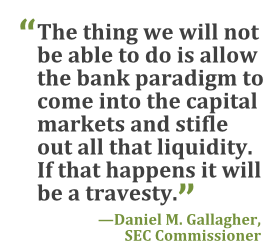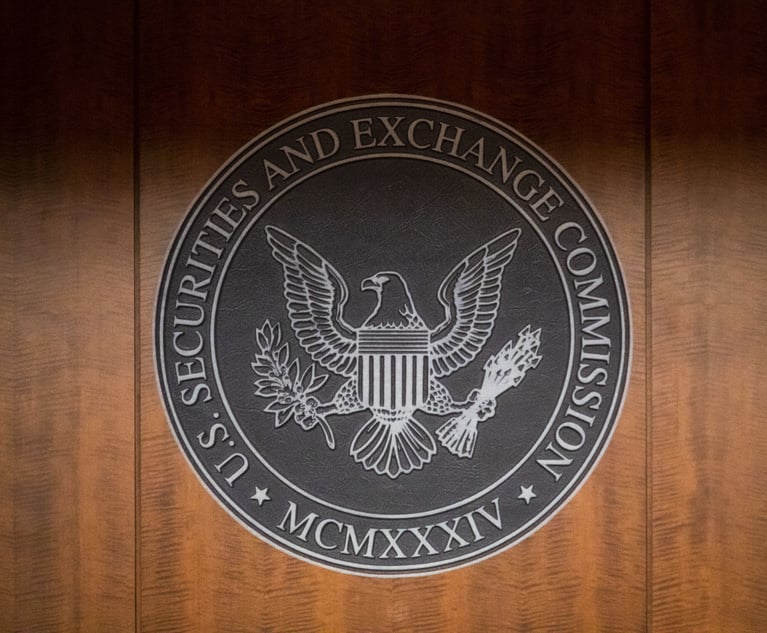U.S. regulators worried that banks and brokerage firms remaintoo dependent on risky types of short-term funding are weighing newrules designed to reduce reliance on parts of what is often calledthe shadow banking system.
|Now the SEC is weighing new funding rules for brokers as well asa limit on leverage similar to those used by the Federal Reserveand other regulators for banks, according to a regulatory documentand SEC officials familiar with the matter.
|The initiatives are aimed at financing tools such as repurchaseagreements, or repos, that were relied on by Bear Stearns Cos. andLehman Brothers Holdings Inc. until their failures accelerated the2008 financial crisis. Lehman's bankruptcy provoked criticism ofthe Securities and Exchange Commission (SEC) for lax oversight ofinvestment banks.
“We all learned during the crisis that the shadow bankingsystem, of which broker-dealers are a part, is subject to runs justlike banks,” said Phillip L. Swagel, a professor at the Universityof Maryland who served as a Treasury Department assistant secretaryduring the crisis. “What seems like highly liquid collateral canturn illiquid during the next crisis.”
|Federal Reserve officials have warned for years that the $4.5trillion web of repo deals remains prone to unravel during a panic,potentially leading to fire sales of assets that could spreadlosses across the financial system.
|Federal Reserve Bank of Boston President Eric Rosengren saidlast year that the SEC's current rules for broker-dealers haven'tchanged enough since the financial crisis.
|The SEC oversees broker-dealers, the largest of which are ownedby big banks supervised by the Fed. Wall Street's largest bonddealers became heavy users of the Fed's emergency-lendingfacilities during the crisis. Their borrowing via two programspeaked at $401 billion on two separate days in September 2008.
|The broker-dealer units of banks including JPMorgan Chase &Co. and Goldman Sachs Group Inc. would be affected by the proposal,as would firms such as Leucadia National Corp.'s Jefferies GroupLLC that aren't within Fed-regulated holding companies.
|In an effort to head off regulators, Wall Street banks andindustry groups are developing a proposal to have a third party,such as the Fixed Income Clearing Corp., process and cleartransactions. That would reduce the risk brokers face from atrading partner's default.
|Raising Cash
|Broker-dealers use repos, or repurchase agreements, to raisecash to finance their inventory of assets and to provide short-termfunding to clients such as hedge funds. For instance, abroker-dealer receives cash in return for collateral, typicallyTreasury bills or notes, that it has the obligation to repurchaseat the original price plus interest. If a broker isn't able torenew the agreement, it can be forced to sell other assets to getneeded cash. Roughly 45 percent of large banks' trading portfoliosare funded by repos, according to an October 2013 report byCitigroup Global Markets Inc.
|Federal Reserve Governor Daniel Tarullo said last month thatregulators may want large, complex banks that house broker-dealersto hold more capital or rely more on longer-term funding. The $71trillion shadow-banking system, which includes the $4.5 trillionmarket for U.S. repos, still isn't adequately protected byregulation, Tarullo said.
|“We have yet to address head-on the financial stability risksfrom securities financing transactions and other forms ofshort-term wholesale funding that lie at the heart of shadowbanking,” Tarullo told the Senate Banking Committee on Feb. 6.
||One measure of a broker's indebtedness is the ratio of itsassets to capital. U.S. broker-dealer leverage reached 40-to-1 in2007 before falling to 22-to-1 in 2012, according to the mostrecent annual report of the Financial Stability Oversight Council(FSOC), an umbrella group of U.S. regulators led by the TreasurySecretary. Broker-dealers' leverage is still “significantly higher”than that of commercial banks, according to FSOC.
|Brokers contend that their borrowing is generally less riskythan bank lending. Repo borrowing, for instance, is backed bycollateral that can be readily sold to raise cash in case the otherparty defaults, said Steven Lofchie, co-chairman of the financialservices group at Cadwalader, Wickersham & Taft LLP.
|“If you think about a bank that is lending 90 percent against ahouse, versus a broker-dealer taking in 102 percent against a loanof a security, the broker dealer's credit risk is exponentiallyless,” Lofchie said.
|SEC Commissioner Daniel M. Gallagher said the agency should showits “learned lessons from the crisis” and should consider the Fed'sviews. At the same time, the agency's capital rules should remainfocused on protecting customers, not trying to shield brokers fromthe possibility of failure.
|“The thing we will not be able to do is allow the bank paradigmto come into the capital markets and stifle out all thatliquidity,” Gallagher, a Republican, said in an interview. “If thathappens it will be a travesty.”
|Some brokers may already be subject to stricter leverage limitsthrough rules imposed on their parent companies. In July, the Fedproposed a stricter leverage limit for the eight largest U.S.banks, most of which also own large broker-dealers. Last month itvoted to apply similar standards to the U.S. operations of foreignbanks with more than $50 billion in assets, which also relied onthe Fed's emergency lending programs during the crisis.
|Reach Expanded
|The SEC rules would expand the reach of such rules, since theywould apply to all of the largest broker-dealers, not only thoseowned by banks. The rules also would try to ensure a bank-ownedbroker doesn't remain dangerously leveraged even as its parent bankcomplies with the Fed's limit by paring back assets or activitiesin other businesses.
|The Fed's “bank capital rules apply on a consolidated basisacross all the subsidiaries, which will include thebroker-dealers,” said Michael P. Jamroz, a former SEC lawyer andexpert on broker capital rules who is now a partner at Deloitte& Touche LLP. “It has an impact right now, today.”
|The SEC is now considering changes to its own capital rules,including placing a cap on brokers' borrowing and imposing acushion of liquid assets to rely on in a crisis. While the SEC'scurrent rules require the largest brokers to maintain a capitalcushion of at least $5 billion, they don't set a strict cap onleverage.
|In a regulatory document issued last year, the SEC said it'sconsidering setting a maximum leverage ratio for broker-dealers.While it's unclear whether the SEC will define the ratiodifferently from the Fed, SEC Chairman Mary Jo White has warnedagainst imposing bank-like standards on broker-dealers.
|A leverage ratio like the one currently used by bankingregulators would make brokers' leverage appear much higher bycounting their repo borrowing, said Jefferson Duarte, a financeprofessor at Rice University.
|White told a conference last month that the agency is planningto update its capital rules for brokers while seeking “to avoid arigidly uniform regulatory approach solely defined by the safetyand soundness standard that may be more appropriate for bankinginstitutions.”
|Capital Cushion
|In addition to a leverage cap, the SEC is weighing another rulethat would require brokers to set aside enough cash and easily soldassets to survive a period during which borrowing costs spike orcreditors restrict funding, according to a person familiar with thematter who asked to not be named because the effort isn't publicyet.
|The SEC's proposal may apply to the roughly 200 broker-dealersthat hold customers' assets, and the firms may be asked to conductmonthly stress tests to determine whether they're prepared for suchconditions, the person said.
|“Those are the ones that are arguably systemic,” said JamesFanto, a law professor at Brooklyn Law School and co-director ofits Center for the Study of Business Law & Regulation. “Theyare the ones you worry about if they go down because they are incharge of the money and the securities.”
|Copyright 2018 Bloomberg. All rightsreserved. This material may not be published, broadcast, rewritten,or redistributed.
Complete your profile to continue reading and get FREE access to Treasury & Risk, part of your ALM digital membership.
Your access to unlimited Treasury & Risk content isn’t changing.
Once you are an ALM digital member, you’ll receive:
- Critical Treasury & Risk information including in-depth analysis of treasury and finance best practices, case studies with corporate innovators, informative newsletters, educational webcasts and videos, and resources from industry leaders.
- Exclusive discounts on ALM and Treasury & Risk events.
- Access to other award-winning ALM websites including PropertyCasualty360.com and Law.com.
*May exclude premium content
Already have an account? Sign In
© 2024 ALM Global, LLC, All Rights Reserved. Request academic re-use from www.copyright.com. All other uses, submit a request to [email protected]. For more information visit Asset & Logo Licensing.







